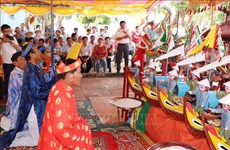Delta to heat up tourism industry
The Ministry of Culture, Sports and Tourism has approved a plan to
develop tourism as a key economic sector in the Mekong Delta.
The Ministry of Culture, Sports and Tourism has approved a plan to
develop tourism as a key economic sector in the Mekong Delta.
The plan, which extends to 2020, will aid in the country's economic transformation and help reduce hunger and poverty, according to the ministry.
The main goals are to diversify tourism products and fully exploit the country's tourism potential.
The plan calls for linkage among provinces and cities in the region and additional investment in tourism projects of international standards.
Under the plan, the Mekong Delta region would focus on the overseas Vietnamese community and Southeast Asian tourism market, especially Cambodia , while maintaining current markets in Northeast Asia, Western Europe and North America .
Domestically, the area aims to attract more tourists as well, particularly from HCM City and Hanoi , and the southeastern region.
The Delta region hopes to welcome 2.7 million foreign visitors and 5.3 million domestic tourists by 2015, according to the plan.
By 2020, the region expects to receive 3.9 million foreign tourists and 6.5 million local visitors. By 2015, there would be 37,150 hotel rooms and a total of 50,000 by 2020.
The aim is to employ 154,700 people in the Mekong Delta tourism sector by 2015 and 236,600 by 2020.
The Mekong Delta region would focus on developing rural tourism (orchard and river tours combined with home-stays); cultural tourism (exploration of ethnic cultures), eco-tourism (tours of ecological systems in the area), and high-quality spa therapy tourism (including Kien Giang province's Phu Quoc Island and Ha Tien town).
In recent years, the Mekong Delta has attained significant achievements in tourism, according to Huynh Vinh Ai, Deputy Minister of Culture, Sports and Tourism.
For example, in 2009 the number of foreign visitors to the region reached 1.2 million, three times higher than in 2000, while local tourists were 8 million compared to 3.4 million in 2000, resulting in revenue of 2 trillion VND for the tourism industry.
Tourism in the Mekong Delta region has also created stable jobs and raised the income of local residents, according to Ai.
According to the recently approved plan, the Mekong Delta region would concentrate investment in hotels, high-quality resorts and recreational sites of international standard.
It would also aim to preserve and enhance the environment, develop festivals to diversify tourism products, train more tourism staff, and conduct research on applying technology in the tourism industry.
The Mekong Delta can be reached by air, land, river or sea. The region has airports in Can Tho City, Phu Quoc Island , Rach Gia town and Ca Mau province.
Under the ministry's plan, two international airports will be built.
Located in southwest Vietnam , the Mekong Delta region, with an area of nearly 40,000 square kilometres and a population of 18 million, includes 12 provinces and one major city, Can Tho. The region extends from Long An province in the north to Ca Mau province in the south./.
The plan, which extends to 2020, will aid in the country's economic transformation and help reduce hunger and poverty, according to the ministry.
The main goals are to diversify tourism products and fully exploit the country's tourism potential.
The plan calls for linkage among provinces and cities in the region and additional investment in tourism projects of international standards.
Under the plan, the Mekong Delta region would focus on the overseas Vietnamese community and Southeast Asian tourism market, especially Cambodia , while maintaining current markets in Northeast Asia, Western Europe and North America .
Domestically, the area aims to attract more tourists as well, particularly from HCM City and Hanoi , and the southeastern region.
The Delta region hopes to welcome 2.7 million foreign visitors and 5.3 million domestic tourists by 2015, according to the plan.
By 2020, the region expects to receive 3.9 million foreign tourists and 6.5 million local visitors. By 2015, there would be 37,150 hotel rooms and a total of 50,000 by 2020.
The aim is to employ 154,700 people in the Mekong Delta tourism sector by 2015 and 236,600 by 2020.
The Mekong Delta region would focus on developing rural tourism (orchard and river tours combined with home-stays); cultural tourism (exploration of ethnic cultures), eco-tourism (tours of ecological systems in the area), and high-quality spa therapy tourism (including Kien Giang province's Phu Quoc Island and Ha Tien town).
In recent years, the Mekong Delta has attained significant achievements in tourism, according to Huynh Vinh Ai, Deputy Minister of Culture, Sports and Tourism.
For example, in 2009 the number of foreign visitors to the region reached 1.2 million, three times higher than in 2000, while local tourists were 8 million compared to 3.4 million in 2000, resulting in revenue of 2 trillion VND for the tourism industry.
Tourism in the Mekong Delta region has also created stable jobs and raised the income of local residents, according to Ai.
According to the recently approved plan, the Mekong Delta region would concentrate investment in hotels, high-quality resorts and recreational sites of international standard.
It would also aim to preserve and enhance the environment, develop festivals to diversify tourism products, train more tourism staff, and conduct research on applying technology in the tourism industry.
The Mekong Delta can be reached by air, land, river or sea. The region has airports in Can Tho City, Phu Quoc Island , Rach Gia town and Ca Mau province.
Under the ministry's plan, two international airports will be built.
Located in southwest Vietnam , the Mekong Delta region, with an area of nearly 40,000 square kilometres and a population of 18 million, includes 12 provinces and one major city, Can Tho. The region extends from Long An province in the north to Ca Mau province in the south./.











